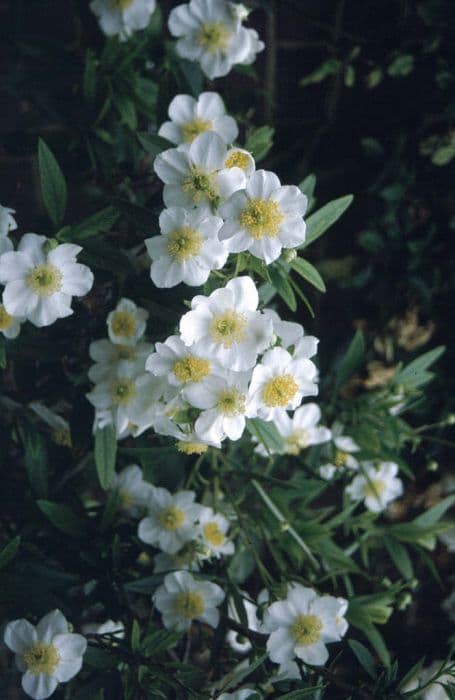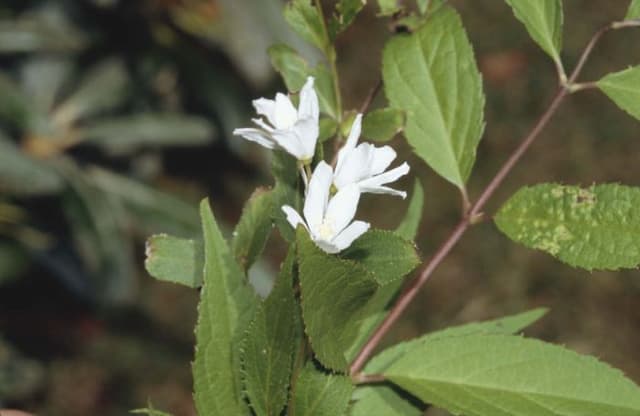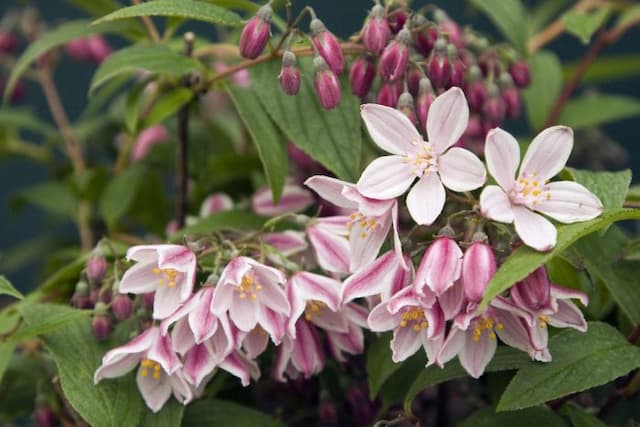Hydrangea Villosa Group Hydrangea aspera Villosa Group

ABOUT
H. aspera Villosa Group is a large upright deciduous shrub with large, velvety ovate leaves. Flowers mauve, in flat heads to 20cm in width, with white sterile florets, in late summer
About this plant
 Names
NamesFamily
Hydrangeaceae.
Synonyms
Rough-leaf Hydrangea, Hairy Hydrangea, Velvet Hydrangea.
Common names
Hydrangea aspera Villosa Group.
 Characteristics
CharacteristicsLife cycle
Perennials
Foliage type
Deciduous
Color of leaves
Green
Flower color
Mixed
Height
10 feet (3 meters)
Spread
10 feet (3 meters)
Plant type
Shrub
Hardiness zones
7
Native area
Asia
Benefits
 General Benefits
General Benefits- Attractive Foliage: Hydrangea aspera Villosa Group has large, velvety leaves that add a unique texture to the garden.
- Striking Flowers: It produces large, showy flower heads that are a mix of purple, blue, and pink, attracting attention from passersby.
- Garden Diversity: Adds variety to a garden due to its distinct foliage and flower structures compared to other common garden plants.
- Shade Tolerance: Can grow in partially shaded areas where many other flowering plants might not thrive.
- Pollinator Friendly: The flowers attract bees, butterflies, and other beneficial insects, supporting local ecosystems.
- Seasonal Interest: Offers visual interest throughout its blooming season, which lasts from late summer to early autumn.
- Architectural Plant: Its large size and robust appearance make it a good choice for creating garden structure or as a backdrop for other plants.
- Easy Propagation: Can be easily propagated from cuttings, making it a cost-effective option for garden expansion.
- Low Maintenance: Requires minimal upkeep once established, aside from regular watering and occasional pruning.
- Cold Hardy: Capable of withstanding cold temperatures, it is suitable for a variety of climates.
 Medical Properties
Medical PropertiesThis plant is not used for medical purposes.
 Air-purifying Qualities
Air-purifying QualitiesThis plant is not specifically known for air purifying qualities.
 Other Uses
Other Uses- Papermaking: The bark and fibers of the Hydrangea aspera Villosa Group can be used to produce a high-quality paper with a distinctive texture and appearance.
- Dye Production: The leaves and blooms can be used to create natural dyes for textiles, yielding colors from pale greens to soft blues depending on the mordant used.
- Garden Aesthetics: The Hydrangea Villosa is often used in landscaping for its large, velvety foliage and textured flower heads, which add visual interest and contrast in garden design.
- Dried Floral Arrangements: The flowers of the Hydrangea Villosa, when dried, retain their shape and color, making them an excellent choice for long-lasting floral displays.
- Horticultural Education: This species is used in botanical gardens and educational programs to teach about plant biology and the diversity of flowering shrubs.
- Photography: The unique appearance of the Hydrangea Villosa flower heads makes them a popular subject for photographers, particularly those specializing in botanical themes.
- Artistic Inspiration: Artists may use the Hydrangea Villosa as inspiration for works of art, including paintings, drawings, and textile designs.
- Culinary Experiments: While not traditionally edible, some enthusiasts use the blooms for culinary decoration, though care should be taken due to potential toxicity.
- Composting: The fallen leaves and spent blooms can be composted to create a rich organic matter that benefits garden soils.
- Privacy Screening: The dense growth habit of the Hydrangea Villosa makes it a suitable plant for creating a living privacy screen in the landscape.
Interesting Facts
 Feng Shui
Feng ShuiThe plant commonly known as Rough Hydrangea is not used in Feng Shui practice.
 Zodiac Sign Compitability
Zodiac Sign CompitabilityThe Rough Hydrangea is not used in astrology practice.
 Plant Symbolism
Plant Symbolism- Understanding: Hydrangeas are sometimes seen as symbolizing a deep level of comprehension and enlightenment, as they have many small, intricate parts that come together to create the whole.
- Heartfelt Emotions: With their lush, full heads and variety of colors, hydrangeas commonly represent the diversity of human emotion and can convey heartfelt feelings.
- Gratitude: The abundant and lavish blooms of the hydrangea are often given as a gesture of thanks, symbolizing appreciation and thankfulness.
- Apology: In some contexts, hydrangeas can symbolize an apology or a desire for reconciliation, as they can communicate the giver’s regret and wish to make amends.
- Boastfulness or Vanity: Due to the plant's showy nature, it was sometimes used to represent vanity or boastfulness in the language of flowers, or floriography, during the Victorian era.
 Water
WaterFor the rough-leaved hydrangea (Hydrangea aspera Villosa Group), consistent moisture is important, especially during hot or dry periods. During the growing season, water thoroughly once a week, making sure the soil is moist but not saturated. A good rule of thumb is to provide about one inch of water per week, which is roughly equivalent to 0.5 gallons for a small shrub. Adjust the amount based on rainfall and temperature, ensuring increased watering in extreme heat. In the dormant season, reduce watering, but do not allow the soil to become completely dry.
 Light
LightThe rough-leaved hydrangea prefers dappled shade or morning sun with afternoon shade to protect it from the intense heat of the day. This plant thrives in a spot where it receives filtered sunlight, avoiding the harsh midday sun which can scorch its leaves. An ideal location would be under the canopy of tall trees or on the north or east side of a building.
 Temperature
TemperatureThe rough-leaved hydrangea is hardy and tolerates a range of temperatures but prefers an environment where the temperature is between 60°F and 80°F for optimal growth. While it can survive minimum winter temperatures down to about 20°F, it should be protected from harsh, cold winds. During the summer, excessive heat above 90°F may stress the plant, so providing some shade can help mitigate the potential damage from the heat.
 Pruning
PruningPruning the rough-leaved hydrangea in late winter or early spring encourages healthy growth and enhances blooming. Remove any dead or crossing branches to improve air circulation and cut back about a third of the oldest stems to aid in rejuvenation. Pruning should ideally occur before new growth starts, as this species blooms on old wood, and pruning too late can remove the current year's flowers.
 Cleaning
CleaningAs needed
 Soil
SoilRough-leaved Hydrangeas require a soil mix that is rich in organic matter, well-draining yet moisture-retentive. A combination of loamy garden soil, peat moss, and perlite or coarse sand in equal parts can be ideal. The pH should be mildly acidic, around 5.5 to 6.5, to encourage vibrant foliage and bloom colors.
 Repotting
RepottingRough-leaved Hydrangeas typically need repotting every 2-3 years to ensure they have enough room to grow and to refresh the soil. However, mature plants can be repotted less frequently, as long as they are not showing signs of being pot-bound or nutrient deficiencies.
 Humidity & Misting
Humidity & MistingRough-leaved Hydrangeas thrive in environments with moderate to high humidity. Aim for a humidity level around 50-60% for optimal growth. These plants appreciate a moist atmosphere but can tolerate slightly lower humidity levels when other conditions are favorable.
 Suitable locations
Suitable locationsIndoor
Place in indirect light, ensure high humidity, maintain moist soil.
Outdoor
Partial shade, protect from afternoon sun, enrich soil, mulch well.
Hardiness zone
7-9 USDA
 Life cycle
Life cycleHydrangea aspera, commonly known as rough hydrangea, begins its life as a seed, which germinates in moist, well-draining soil under partial to full shade. Sprouting occurs in early spring, growing into a seedling with leaves and a root system establishing quickly. As a juvenile, the hydrangea's stems and foliage develop over the spring and summer, with the plant maturing over several years to its full size, with a shrubby form characterized by hairy leaves and stems. Once mature, typically within 2-4 years, the hydrangea produces large, flat-topped flower clusters in the summer, with blooms consisting of both showy sterile flowers and smaller fertile flowers. After pollination, the plant sets seed in the fall, which are dispersed nearby, perpetuating the cycle. The plant enters dormancy during winter, shedding leaves where the climate is colder and resting before beginning the next year's growth cycle.
 Propogation
PropogationPropogation time
Summer to early fall
The Hydrangea aspera Villosa Group, commonly known as rough-leaved hydrangea, can be propagated from semi-hardwood cuttings during the late summer. To do so, one must select a healthy stem that has new growth but has begun to firm up. Cut a 4 to 6 inch (approximately 10 to 15 centimeters) section from the stem just below a leaf node, and remove the lower leaves. The cutting should then be dipped in rooting hormone to encourage root development and planted in a well-draining potting mix. It’s important to maintain consistent moisture and provide indirect light until roots have established, after which the new hydrangea plant can be transplanted outdoors.








![Hydrangea [Strong Annabelle]](/_next/image?url=https%3A%2F%2Fplants-admin.emdemapps.com%2Fimages%2Fplants%2F%2Fimages%2F604b54db37d34.png&w=640&q=75)
